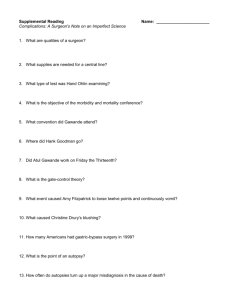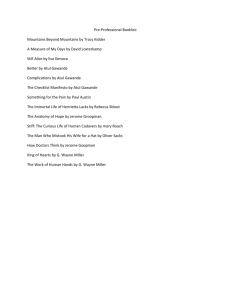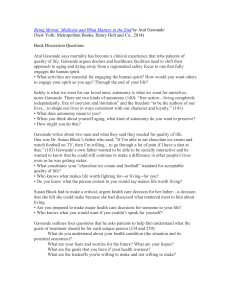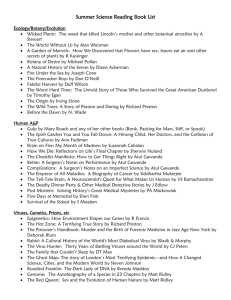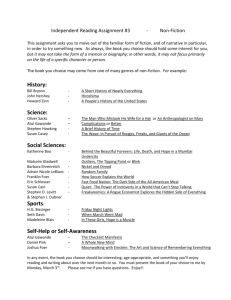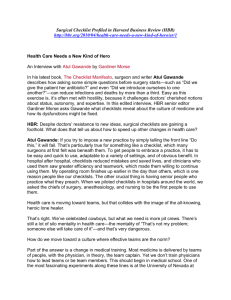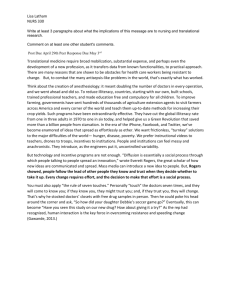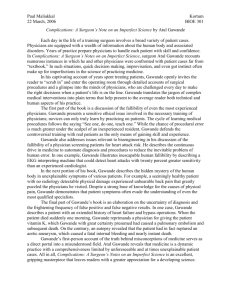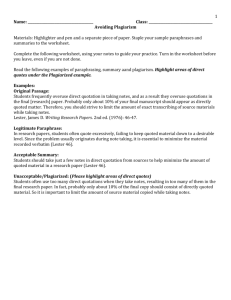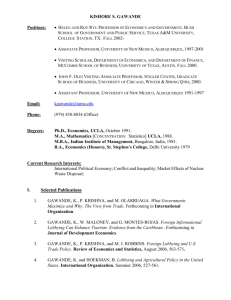Morgan Feshler - Middletown Public Schools
advertisement
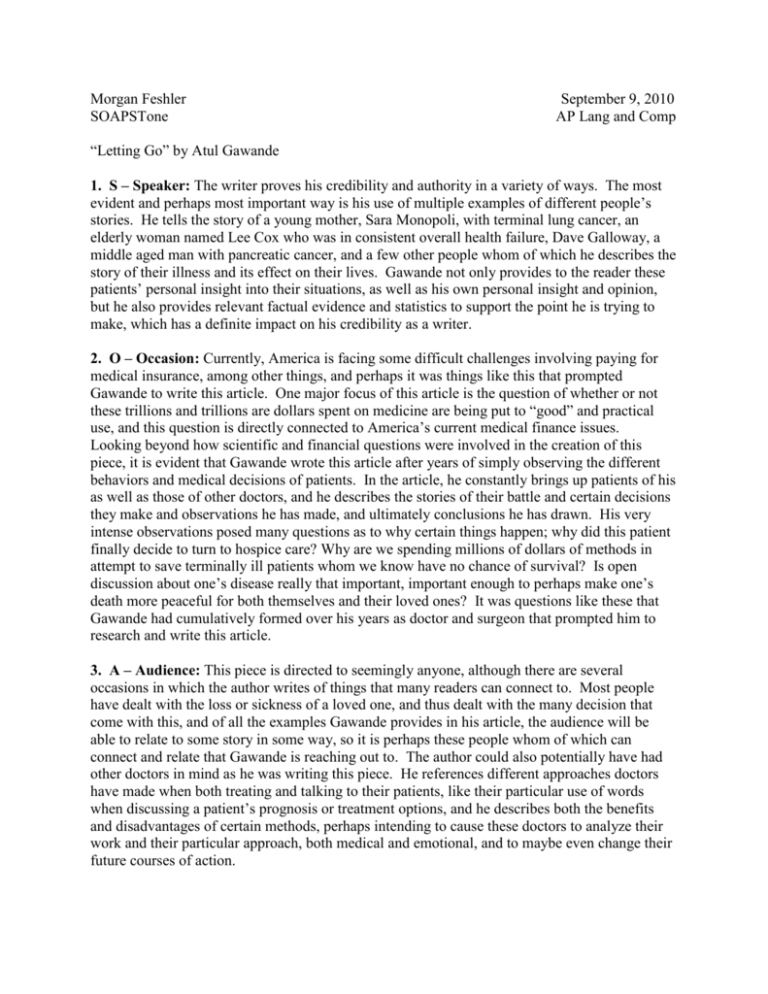
Morgan Feshler SOAPSTone September 9, 2010 AP Lang and Comp “Letting Go” by Atul Gawande 1. S – Speaker: The writer proves his credibility and authority in a variety of ways. The most evident and perhaps most important way is his use of multiple examples of different people’s stories. He tells the story of a young mother, Sara Monopoli, with terminal lung cancer, an elderly woman named Lee Cox who was in consistent overall health failure, Dave Galloway, a middle aged man with pancreatic cancer, and a few other people whom of which he describes the story of their illness and its effect on their lives. Gawande not only provides to the reader these patients’ personal insight into their situations, as well as his own personal insight and opinion, but he also provides relevant factual evidence and statistics to support the point he is trying to make, which has a definite impact on his credibility as a writer. 2. O – Occasion: Currently, America is facing some difficult challenges involving paying for medical insurance, among other things, and perhaps it was things like this that prompted Gawande to write this article. One major focus of this article is the question of whether or not these trillions and trillions are dollars spent on medicine are being put to “good” and practical use, and this question is directly connected to America’s current medical finance issues. Looking beyond how scientific and financial questions were involved in the creation of this piece, it is evident that Gawande wrote this article after years of simply observing the different behaviors and medical decisions of patients. In the article, he constantly brings up patients of his as well as those of other doctors, and he describes the stories of their battle and certain decisions they make and observations he has made, and ultimately conclusions he has drawn. His very intense observations posed many questions as to why certain things happen; why did this patient finally decide to turn to hospice care? Why are we spending millions of dollars of methods in attempt to save terminally ill patients whom we know have no chance of survival? Is open discussion about one’s disease really that important, important enough to perhaps make one’s death more peaceful for both themselves and their loved ones? It was questions like these that Gawande had cumulatively formed over his years as doctor and surgeon that prompted him to research and write this article. 3. A – Audience: This piece is directed to seemingly anyone, although there are several occasions in which the author writes of things that many readers can connect to. Most people have dealt with the loss or sickness of a loved one, and thus dealt with the many decision that come with this, and of all the examples Gawande provides in his article, the audience will be able to relate to some story in some way, so it is perhaps these people whom of which can connect and relate that Gawande is reaching out to. The author could also potentially have had other doctors in mind as he was writing this piece. He references different approaches doctors have made when both treating and talking to their patients, like their particular use of words when discussing a patient’s prognosis or treatment options, and he describes both the benefits and disadvantages of certain methods, perhaps intending to cause these doctors to analyze their work and their particular approach, both medical and emotional, and to maybe even change their future courses of action. 4. P – Purpose: Gawande’s claim and argument is that too much money is put into trying to save terminally ill patients’ lives by intensifying chemotherapy or performing major surgery that will have little to no effect on their lifespan, simply because the doctor isn’t willing to flat out give the patient and family the option of giving up, and because the patient isn’t willing to let go. Gawande explains that by undergoing all of this intense and debilitating treatment at the end of their lives, patients dramatically reduce the quality of those last few days they have, because they’re hooked up to a machine or suffering from some of the drugs’ harshest side effects, leaving them unable to live those last few days and die peacefully. He also talks about how important honesty between doctor and patient is, and not only this, but how important the doctor’s particular choice of words can be and how much of a difference it makes when instead of saying, “‘What do you want when you are dying?”’(13) you say, ‘“If time becomes short, what is most important to you?”’(13). By explaining to the reader all these things, it gives them much to think about, and perhaps Gawande wanted to have an influence on certain future decisions of terminally ill patients and their families as far as treatment and care options when it gets closer to the end. Gawande’s friend and hospice nurse Sarah Creed explains that, “In ordinary medicine, the goal is to extend life. We’ll sacrifice the quality of your existence nowby performing surgery, providing chemotherapy, putting you in intensive care-for the chance of gaining time later. Hospice deploys nurses, doctors, and social workers to help people with a fatal illness have the fullest possible lives right now. That means focusing on objectives like freedom from pain and discomfort, or maintaining mental awareness for as long as possible, or getting out with family once in a while,”(5). All terminally ill patients have the option of this, or to keep fighting and debilitate themselves in those last few moments of their life. Gawande wants to express this to the readers, and hopefully have an influence on certain decisions they make if ever faced with ones as such, perhaps encouraging them to focus on quality of life, rather than the length. 5. S – Subject: The subject and main discussion of this article is the question of why so many terminally ill patients opt to keep fighting despite all the odds against their survival, instead of turning to hospice and focusing on improving the quality of their last days, and it also greatly focuses on the positive effects of honest and open discussion between doctor and patient, family and patient, etc., and how affective this is on when the patient dies and exactly how they leave this world and their loved ones behind. The subject of this article is both explicitly stated and indirectly implied. There is not one specific quote, necessarily, that definitively states the subject, however, the multiple examples of particular patients’ story supports the claims of importance of discussion, the choice of certain patients as to how to spend their last days, etc. extremely well and directly. 6. Tone: There is definitely a tone of sincerity in the article. As he discusses the stories of the patients, Gawande doesn’t just factually tell the story, but he tells it with sympathy, admiration, and even fascination, which all seem to tie together and create this sincere piece. As he uses harsh words seemingly too truthful, Gawande somehow is able to put sentences together in a way that is not so harsh, but simply honest and sincere. For example, “…Sara ended up on a fourth round of chemotherapy, one with a minuscule likelihood of altering the course of her disease and a great likelihood of causing debilitating side effects. An opportunity to prepare for the inevitable was forgone. And it all happened because of an assuredly normal circumstance: a patient and a family unready to confront the reality of her disease,”(8). The words in these sentences and the harsh reality they are describing are brutally honest, however, at the end of it, the reader feels this sense of sympathy and sincerity from the author, who had stated that all of what Sara was going through was incredibly useless and perhaps worse than the option of just accepting the fact that she was dying, and do so peacefully, yet he did not necessarily disagree or say she was wrong, for Gawande understands how hard it is to just give up and accept death.
